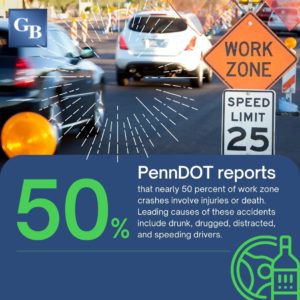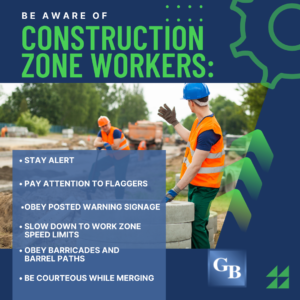What Are Work Zone Dangers?
Workers being hit by a vehicle is by far the leading cause of highway worker injury and death. The Federal Highway Administration (FWHA) lists large trucks and buses as the leading vehicles involved in worker fatalities. However, pickup trucks, semis, tractor-trailers, SUVs, vans, and equipment vehicles are also threats. Speeding was a factor in a significant number of work zone crashes.
The National Institute for Occupational Safety and Health (NIOSH) reports the additional common highway work zone hazards.
Proximity
Flaggers and other on-foot workers who work near passing vehicles and construction equipment are at risk for significant bodily injury due to being struck by vehicles or equipment.
Road/Weather Conditions
Every highway worker faces risks associated with poor visibility, inclement weather, slick roads, and poor lighting. Passing cars may spin out of control or not see a highway worker.
Distracted Drivers
Using a cellphone is the top distraction among drivers and the cause of many car accidents. Drivers who are not paying attention for whatever reason may not notice signs for upcoming construction, narrowing or merging lanes, or detours. Consequently, they may crash into work zones, injuring workers on site.
Drunk or Drugged Drivers
People who drive under the influence often find it challenging to maintain lanes or react in time to changing traffic or road conditions. Unfortunately, they can quickly strike a construction worker, causing serious injury or death.
Obstacles/Debris
Debris and other obstacles in the road can cause drivers to veer into a work zone accidentally. Distracted drivers may also fail to notice barricades or other traffic-control devices in work zones.
Speeding Drivers
Signs typically warn drivers of upcoming work zones and lowered speed limits. Drivers who ignore these warnings may not be able to slow down in time to avoid crashing into a person or object in a work zone.
Runovers
Heavy construction equipment needs space to work smoothly. Workers who are inattentive or inadequately trained can be run over or backed over by construction vehicles.
Caught-in/Between Accidents
According to the Occupational Safety and Health Administration (OSHA), being caught in or between heavy objects or equipment or cars that veer into the work zone is one of the top causes of construction worker deaths.
Collision/Overturn Accidents
Workers who operate heavy machinery or construction vehicles risk injury due to collision or overturn.
Falls
Highway construction workers must sometimes work on an elevated surface or platform. Falls from malfunctioning equipment or safety shortcuts can cause significant injury.
Electrocution
Highway workers will often work with electrical equipment. Electrocution and shock can happen if the equipment is defective, worn, improperly grounded, or has not been maintained.
Faulty Equipment or Vehicles
Sometimes, a hardhat or other protective device will fail due to defects, or work equipment or vehicles can be found defective after causing an accident. It is always essential to test equipment and vehicles for defects after an accident.
Overexertion
Workers can suffer heat-related injuries and overexertion from the heavy physical labor and long hours working outside.
 Google Screened
Google Screened


